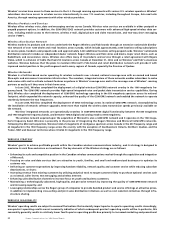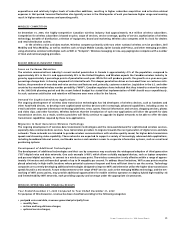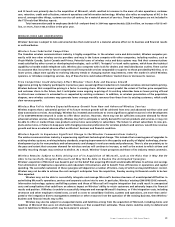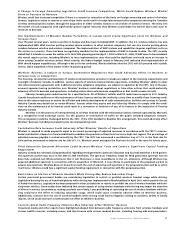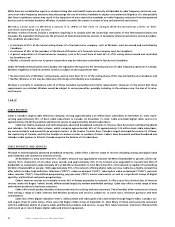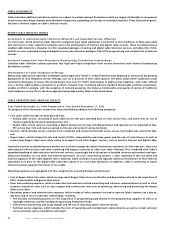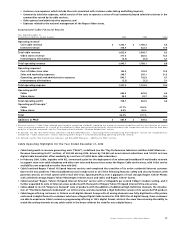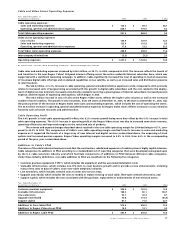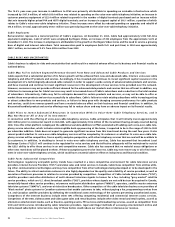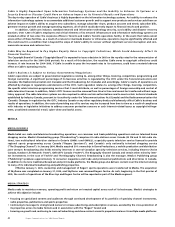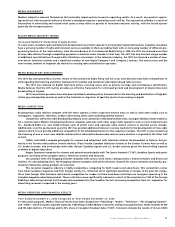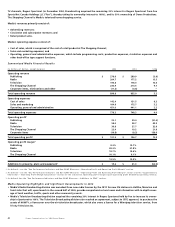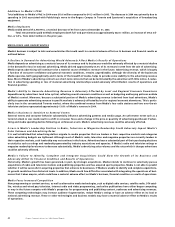Rogers 2004 Annual Report Download - page 36
Download and view the complete annual report
Please find page 36 of the 2004 Rogers annual report below. You can navigate through the pages in the report by either clicking on the pages listed below, or by using the keyword search tool below to find specific information within the annual report.
34 Rogers Communications Inc. 2004 Annual Report
CABLE SEASONALITY
Cable subscriber additions and disconnections are subject to modest seasonal fluctuations which are largely attributable to movements
of university and college students and individuals temporarily suspending service due to extended vacations. These fluctuations gener-
ally have a minimal impact on Cable’s financial results.
RECENT CABLE INDUSTRY TRENDS
Investment in Improved Cable Television Networks and Expanded Service Offerings
In recent years, North American cable television companies have made substantial investments in the installation of fibre-optic cable
and electronics in their respective networks and in the development of Internet and digital cable services. These investments have
enabled cable television companies to offer expanded packages of analog and digital cable television services, including VOD, SVOD,
and PPV services; expanded analog and digital services, pay television packages, PVR, HDTV programming and multiple tiers of Internet
services.
Increased Competition from Alternative Broadcasting Distribution Undertakings
Canadian cable television systems generally face legal and illegal competition from several alternative multi-channel broadcasting
distribution systems.
Development of Cable Telephony Offerings
Many larger cable system operators or Multiple System Operators (“MSOs”), in North America have deployed or announced the pending
deployment of local telephony service offerings over all or portions of their cable systems. The MSOs utilize either traditional circuit
switched technologies or newer soft-switch-based voice over IP (“VoIP”) technologies to deploy local telephony. VoIP, when offered
over a DOCSIS cable modem connection to an MSO’s network that is utilizing industry standard PacketCable certified components,
enables an MSO to emulate, with the exception of network powering, the features, functionality and quality of service of traditional
local telephone service. This is the same approach being deployed by Cable as discussed above.
CABLE OPERATING AND FINANCIAL RESULTS
Year Ended December 31, 2004 Compared to Year Ended December 31, 2003
For purposes of this discussion, revenue has been classified according to the following categories:
• Core cable, which includes revenue derived from:
• Analog cable service, consisting of basic cable service fees plus extended basic (or tier) service fees, and access fees for use of
channel capacity by third and related parties; and
• Digital cable service revenue, consisting of digital channel service fees, including premium and specialty service subscription fees,
PPV service fees, VOD and revenue earned on the sale and rental of set-top terminals;
• Internet, which includes service revenues from residential and commercial Internet access service and modem sale and rental fees;
and
• Rogers Video, which includes the sale and rental of DVDs, videocassettes and video games and the sale of confectionary, as well as
commissions Rogers Video earns while acting as an agent to sell other Rogers’ services, such as wireless, Internet and digital cable.
Internet service has essentially become another service that leverages the cable infrastructure and which, for the most part, shares the
same physical infrastructure and sales, marketing and support resources as other core cable offerings. This, combined with Cable’s
expanded bundling of cable television and Internet services, increasingly led to allocations of bundled revenues and network and oper-
ating costs between its core cable and Internet operations. As such, commencing January 1, 2003, reporting of the core cable and
Internet segments of the cable segment were combined. Cable continues to provide separate statistical information on their Internet
subscribers as it does for the digital cable subscriber subset of our core cable operations. In addition, Cable is continuing to report
Internet revenues separate from those of core cable.
Operating expenses are segregated into four categories for assessing business performance:
• Cost of Rogers Video store sales, which is composed of Rogers Video store merchandise and depreciation related to the acquisition of
DVDs, videocassettes and game rental assets;
• Sales and marketing expenses, which include sales and retention-related advertising and customer communications as well as other
customer acquisition costs such as sales support and commissions and costs of operating, advertising and promoting the Rogers
Video store chain;
• Operating, general and administrative expenses, which include all other expenses incurred to operate Cable’s business on a day-to-
day basis and to service subscriber relationships, including:
• The monthly contracted payments for the acquisition of programming paid directly to the programming suppliers as well as to
copyright collectives and the Canadian Programming Production Funds;
• Internet interconnectivity and usage charges and the cost of operating Cable’s Internet service;
• Technical service expenses, which includes the costs of operating and maintaining its cable networks as well as certain customer
service activities such as installations and repair;


